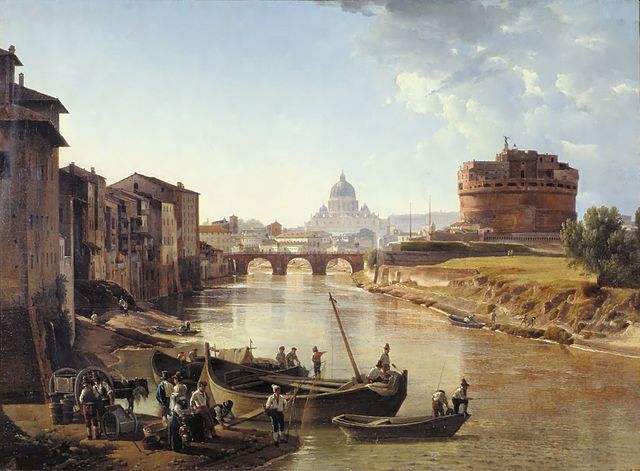Pope Leo XII, born Annibale Francesco Clemente Melchiorre Girolamo Nicola della Genga, was head of the Catholic Church and ruler of the Papal States from 28 September 1823 to his death in February 1829.
Leo XII in 1828
"The Grand Gala Berlin", a luxury carriage constructed in Rome during the first half of the nineteenth century, is an order of the States of the Church during the reign of two pontiffs: Leo XII, in the years 1824–1826, and Gregory XVI, who requested some important modifications. The carriage was used for five solemn festive occasions in the year.
The Tiber with Castel Sant'Angelo, Ponte Sant'Angelo and St. Peter in the time of Leo XII, by Silvestr Feodosievich Shchedrin
Bust of Pope Leo XII, c. 1820s
A cardinal-nephew was a cardinal elevated by a pope who was that cardinal's relative. The practice of creating cardinal-nephews originated in the Middle Ages, and reached its apex during the 16th and 17th centuries. The last cardinal-nephew was named in 1689 and the practice was abolished in 1692. The word nepotism originally referred specifically to this practice, when it appeared in the English language about 1669. From the middle of the Avignon Papacy (1309–1377) until Pope Innocent XII's anti-nepotism bull, Romanum decet pontificem (1692), a pope without a cardinal-nephew was the exception to the rule. Every Renaissance pope who created cardinals appointed a relative to the College of Cardinals, and the nephew was the most common choice, although one of Alexander VI's creations was his own son.
Pietro Ottoboni, the last holder of the post of cardinal-nephew, painted by Francesco Trevisani
The Avignon Papacy (1309–1377) produced an unprecedented number of cardinal-nephews.
Pope Paul III with his cardinal-nephew Alessandro Farnese (left) and his other grandson, Ottavio Farnese, Duke of Parma (right)
Ranuccio Farnese was made cardinal by Paul III at the age of 15.








